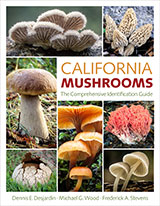The North American Species of Pholiota
139. Pholiota hypholomoides (Murr.) comb. nov.
Gymnopilus hypholomoides Murrill, Mycologia 5: 26. 1913.
Flammula hypholomoides Murrill, Mycologia 5: 36. 1913.
Illustrations: Text figs. 294-296.
Pileus 3-6 cm broad, convex to expanded, viscid (Murrill says dry), subfibrillose, pale-fuscous, ferruginous in the center, margin thin, somewhat folded and uneven, not striate. Context thin, yellowish; of mawkish flavor.
Lamellae sinuate, tawny-yellow to pale-fuscous, inserted, crowded, rather narrow.
Stipe 4-6 cm long, 2-4 mm thick, concolorous, cylindric, curved, fibrillose, solid, tough.
Spores 5.5-7.5 x 4-5 µ, smooth, apical pore present but minute, shape in face view mostly ovate but a few subelliptic, in profile somewhat inequilateral, color in KOH dark tawny, paler in Melzer's reagent, wall about 0.25 µ thick.
Basidia 17-21 (25) x 5-7.5 µ, mostly 4-spored, obese to subutriform, yellow in KOH and Melzer's reagent. Pleurocystidia 45-80 x 6-12 µ (rarely shorter) and up to 20 µ broad, fusoid-ventricose, apex obtuse, wall smooth or with some solidified gelatinous material adhering in places, wall thin to distinctly thickened (up to 1.5 µ in ventricose part, content colloidal, reticulate or diffuse and amber-brown to yellow in KOH fading to nearly hyaline, with rods and particles of solid material often in upper end of neck. Cheilocystidia 34-68 x 7-14 µ, small and subfusoid, to fusoid-ventricose like pleurocystidia but usually wall thin, or thickened from above pedicel to apex (where it is thin). Caulocystidia none found (only dried material examined).
Gill trama a central area of floccose hyphae subparallel in arrangement, the hyphal cells 4-9 µ diam. and inflating to 16 µ or more in age, walls thin, smooth and yellowish in KOH; subhymenium a distinct gelatinous layer of interwoven hyaline hyphae 2-3 µ diam. more or less intricately branched. Pileus cutis a gelatinous pellicle of narrow hyphae over a hypodermium of dark rusty brown (in KOH) floccose heavily incrusted hyphae. Context hyphae interwoven, walls yellowish in KOH (not reviving well in type). Clamp connections present. All hyphae inamyloid.
Habit, Habitat, and Distribution: On soil, apparently attached to buried wood, Jamaica, October, type studied.
Observations: Murrill (1913) states that the pileus surface resembles Hypholoma (Naematoloma) sublateritium. Murrill also describes the pileus as dry, but sections of the type reveal a distinct gelatinous cutis and a hypodermial layer. The pleurocystidia distinguish it at once from the common brick-cap. The color of the mature gills, however, suggests purple brown spores. In the dried material, however, the gill color is that of the P. spumosa group generally. Because of the gelatinous pellicle of the pileus, the large pleurocystidia and the gelatinous subhymenium, the species is unquestionably a Pholiota.

